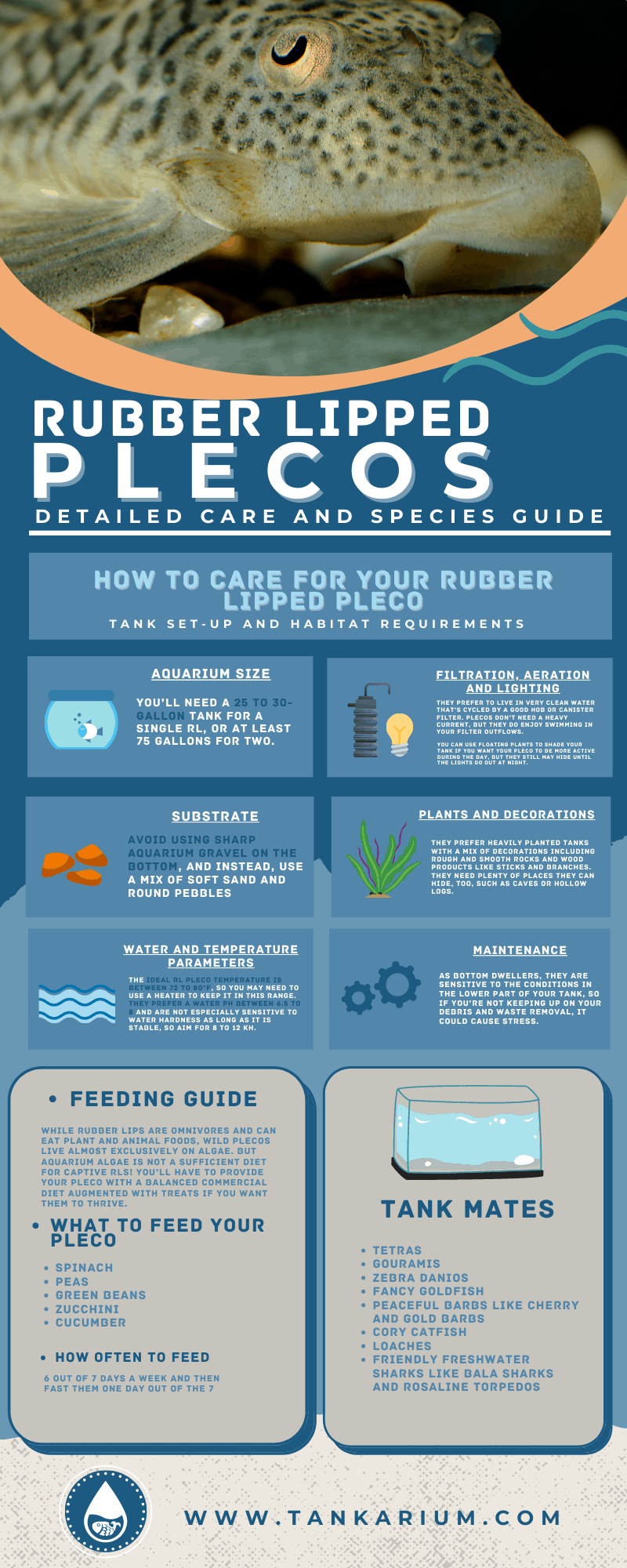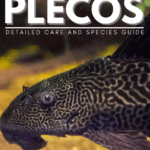It’s easy to overlook the humble plecostomus in the excitement of setting up a new tank, at least until you start having problems with algae. But medium-sized catfish like the rubber lip pleco can be a great addition to a planted freshwater aquarium! They are hearty and easy to care for and make an ideal choice for novice aquarists.
Introduction To Rubber Lipped Plecostomus
When it comes to algae-eating catfish like the Rubber-Lipped Pleco or RL (Chaetostoma milesi), there’s a lot of confusion. These camouflaged scavengers look fierce, with their wide rasping mouths, long pointed dorsal spines, and bony plates that look like armor.
But these bottom-dwelling plecos are really peaceful community fish and usually do well in planted freshwater tanks with other friendly species. Let’s take a quick look at the rubber lip’s basic statistics before we explore their natural history and care requirements.
Scientific Name
Chaetostoma milesi
Common Name (species)
Rubber Lipped Plecostomus, Striped Pleco, Spotted Rubbernose Pleco
Care Level
Easy
Size
Juveniles are sold at 3 to 4 inches in length
Adults can reach up to 7 inches at maturity
Diet
Omnivore but prefers a mostly vegetarian diet
Activity
Mello, curious, shy
Temperament
Peaceful, but can become slightly territorial as they get older
Min Tank Size
25 to 30 gallons
Temperature Range
72 to 80°F
Natural History And Habitat
The rubber lipped pleco is native to South America. They are one of the many closely related species of catfish found throughout the region, and their specific range is along the Magdalena and Apuré River basins in Columbia and Venezuela. They live in shallow freshwater streams and slow-moving rivers.
In the wild, plecos like the RL scavenge for food on the bottom of rivers and hide among the plants, rocks, and logs in the waterways. They are hearty fish that can survive through the seasonal drops in water levels and warmer summertime temperatures. They primarily feed on algae scraped from rocks, wood and plants.
Size And Appearance
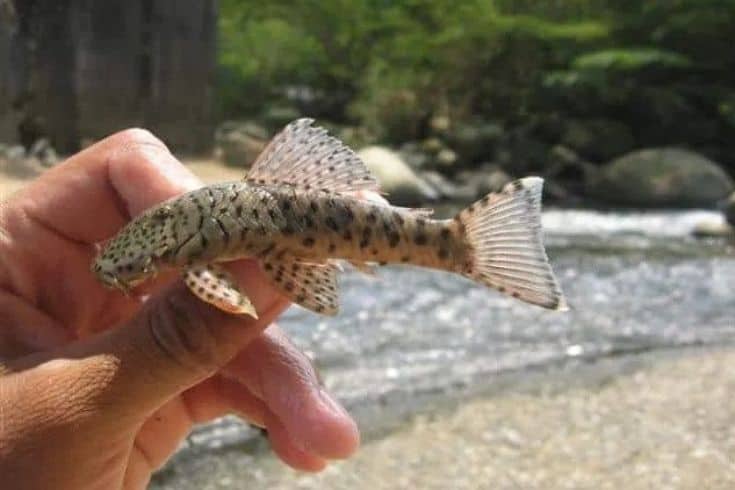
How big do pleco fish get and what size do rubber lips reach? An adult RL rarely gets larger than 7 inches in length. Most rubber lips probably top out at around 5.5 inches when raised in an aquarium environment. Their body has the typical pleco shape, with a wide head and large downward facing (ventral) suckermouth:
- RLs belongs to a group of 150 species of armored catfish that have hard bony plates protecting their bodies instead of typical scales.
- This species has a prominent dorsal fin with 8 dorsal rays (spines) that lie flat against their back when they are still, but stand up like a sail when they are swimming.
- Their pectoral fins are short and held close to their bodies when swimming, and they use them to navigate along river bottoms and even prop themselves up on their pectoral fins while resting.
Rubber lipped plecos are usually a grey to brown color with darker brown to black spots on their heads. Beyond their gill covers, the spots usually turn to a striping pattern, although they may still show spots on their pectoral, anal and adipose fins. Rubber lips do not change colors as they mature, unlike the chubby pleco.
Average Pleco Lifespan
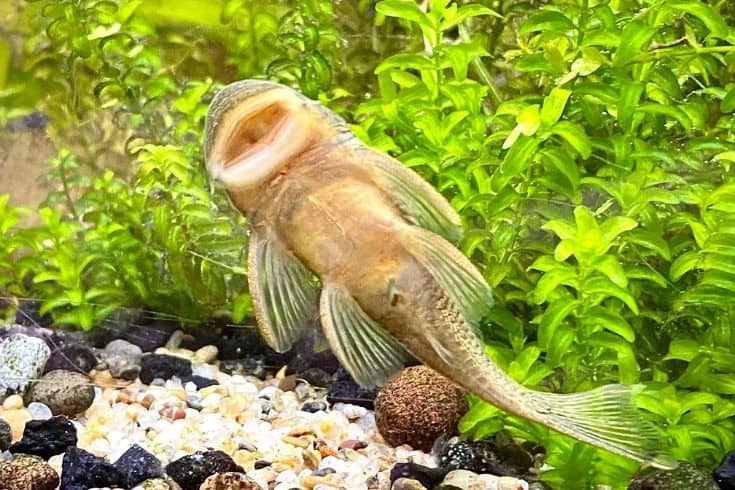
Rubber lipped plecos can live up to 12 years with proper care, but their longevity depends on their habitat, feeding regime, and maintenance routines. Stress caused by inadequate space, erratic feeding, poor hygiene or changing water parameters can dramatically reduce their lifespan.
Activity And Temperament: Are Plecos Aggressive?
The common pleco (Hypostomus plecostomus) is known for its aggression, but this isn’t a problem with RLs. They are friendly and mellow fish that usually get along with other peaceful community species. They tend to be shy and enjoy hiding as they feed amid your plants and decor during the day, but may become more active at night.
Will rubber lipped plecostomus eat other fish? Yes, they are scavengers and will snack on anything that dies in your tank. They will also opportunistically eat any eggs or fry they come across as well:
- But they are not aggressive and don’t usually attack and kill their tank mates.
- As they mature, they can become a bit territorial and might chase other bottom feeders from their preferred area.
- This is why they are not ideal tank mates for bristlenose plecos or similar algae eating bottom feeders unless you have a large tank with room for each to have separate territory.
How To Care For Your Rubber Lipped Pleco
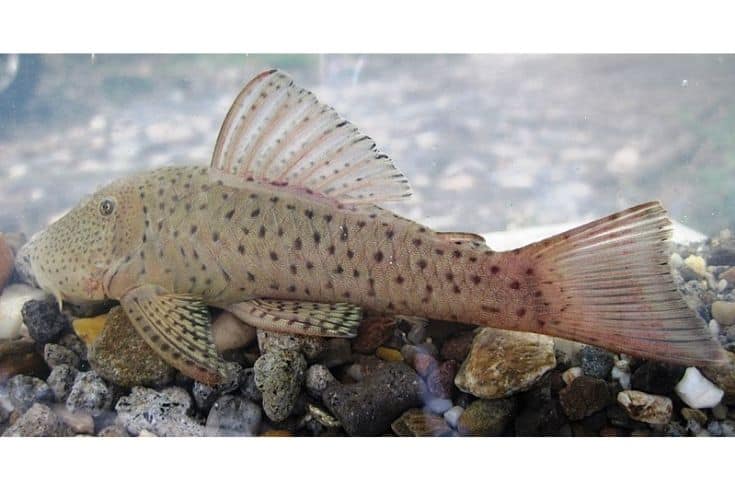
The good news is that RL plecostomus care is not hard, and these fish are easily accommodated in most freshwater community set-ups. Here are their ideal conditions, from their water conditions to their preferred tank size and diet!
Tank Set-up And Habitat Requirements
Setting up a tank for a pleco is not hard as long as you provide them with a few basic necessities. In fact, depending on your current set-up, you may not need to make any adjustments before adding an RL to your community!
Aquarium Size
Rubber lipped plecos need plenty of room and don’t enjoy living in cramped conditions. While juveniles often do well in smaller set-ups, it can cause a lot of stress for them, and as they mature this may restrict their growth and lifespan. You’ll need a 25 to 30-gallon tank for a single RL, or at least 75 gallons for two.
Substrate
Since plecos are bottom-feeding scavengers, they do best with a substrate that won’t cause injury to their abdomens. Avoid using sharp aquarium gravel on the bottom, and instead, use a mix of soft sand and round pebbles. If you need to use a gravel product to support your plant growth, cover the top with a layer of sand for the RL.
Water And Temperature Parameters
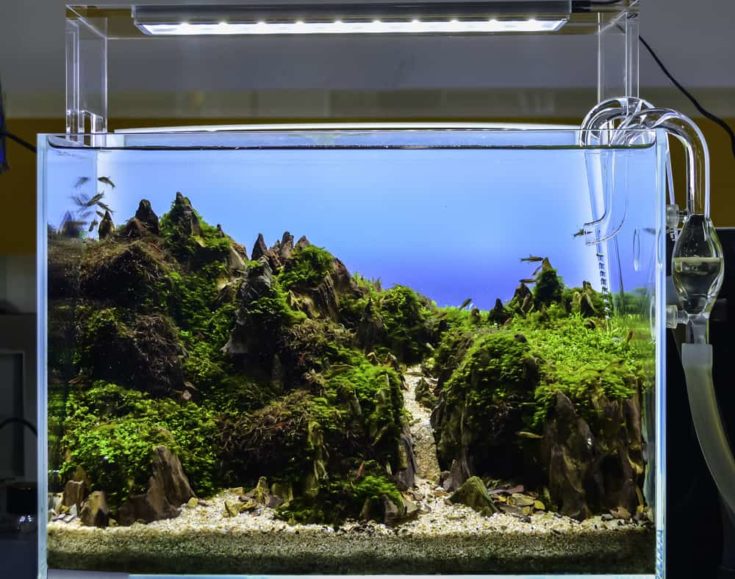
Plecos are ideal algae eaters for both coldwater and tropical tanks. The ideal RL pleco temperature is between 72 to 80°F, so you may need to use a heater to keep it in this range. They prefer a water pH between 6.5 to 8 and are not especially sensitive to water hardness as long as it is stable, so aim for 8 to 12 KH.
Filtration, Aeration And Lighting
Like most aquarium species, RLs are sensitive to ammonia and other toxins that can build up in a dirty tank. They prefer to live in very clean water that’s cycled by a good HOB or canister filter. Plecos don’t need a heavy current, but they do enjoy swimming in your filter outflows.
Since plecos spend most of their time at the bottom of your tank, they are sensitive to Dead Zones and areas of stagnation. Using a bubbler or air stone can help keep the water’s oxygen levels high, and your RL will likely enjoy playing in the bubbles too.
Like many bottom dwellers, RLs don’t like bright lights and may avoid areas of your tank that are well-lit. You can use floating plants to shade your tank if you want your pleco to be more active during the day, but they still may hide until the lights go out at night.
Plants And Decorations
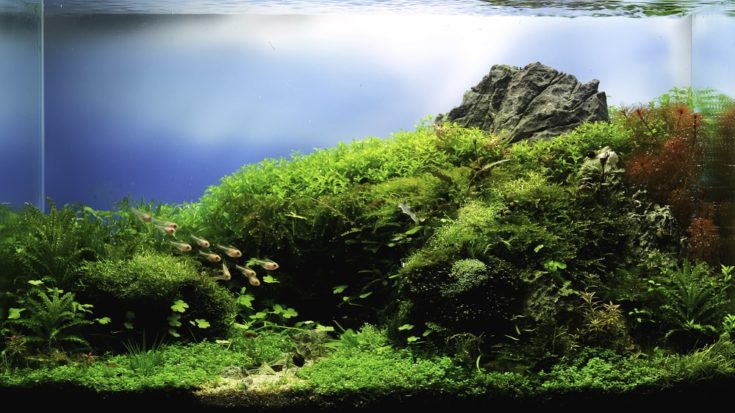
Rubber lips don’t enjoy a bare tank, and having a bare or minimal set-up may cause them a lot of stress. They prefer heavily planted tanks with a mix of decorations including rough and smooth rocks and wood products like sticks and branches. They need plenty of places they can hide, too, such as caves or hollow logs.
Maintenance
If you already have a good routine for your regular filter maintenance and water changes you may not need to change anything to keep your pleco content. As bottom dwellers, they are sensitive to the conditions in the lower part of your tank, so if you’re not keeping up on your debris and waste removal, it could cause stress.
Feeding Guide
What do plecos eat? While rubber lips are omnivores and can eat plant and animal foods, wild plecos live almost exclusively on algae. But aquarium algae is not a sufficient diet for captive RLs! You’ll have to provide your pleco with a balanced commercial diet augmented with treats if you want them to thrive.
What To Feed Your Pleco
Your RL will likely help themself to anything you add to your tank, especially scraps that sink to the bottom. If you’re already giving your other fish live/frozen foods like brine shrimp, bloodworms, and Daphnia eggs then you don’t need to add extra meaty foods for your pleco. It’s best to stick to vegetarian diets for them.
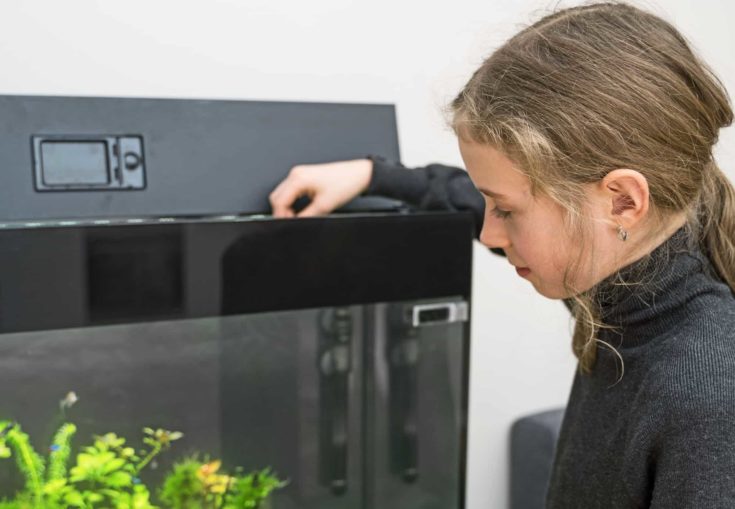
What are some good plecostomus foods? A high-quality diet of sinking algae wafers or pellets is ideal, and then offer a mix of treat foods a couple of times a week. The best treats include blanched veggies such as:
- Spinach
- Peas
- Green beans
- Zucchini
- Cucumber
How Often To Feed
I usually feed my RL plecos 6 out of 7 days a week and then fast them one day out of the 7. I alternate between offering regular and treat foods to ensure they get a balanced diet. I’ll usually feed them their primary diet 4 days a week and then add treats on 2 days. Of course, they’ll also scavenge any leftovers from the other fish.
Tank Mates
What kind of fish get along with rubber lips? Really, there’s a huge number of possibilities. Avoid keeping them with aggressive cichlids and semi-aggressive species like Tiger Barbs, and don’t add them to a tank with a lot of territorial bottom feeders unless there’s room for your pleco to establish their own territory.
The best tank mates for these plecos are other peaceful community fish that prefer similar water conditions. Your option includes (but are not limited to):
- Tetras
- Gouramis
- Zebra danios
- Fancy goldfish
- Peaceful barbs like Cherry and Gold Barbs
- Cory Catfish
- Loaches
- Friendly freshwater sharks like Bala Sharks and Rosaline Torpedos
Breeding
Rubber lips are incredibly hard to breed in a home aquarium, and nearly all the fish you see for sale have been caught in the wild as juveniles. You’d likely need a very large 300+ gallon tank to even have a chance of successful spawning. I’ve never seen anyone actually pull it off, so enjoy your fish but don’t expect babies.
Health
Plecos in general don’t suffer from any specific sickness, and the RL is usually a very healthy and hearty species. If you keep up on your water changes and tank maintenance you’ll reduce the chances of any problems. But if you have an outbreak of ich or a bacterial or viral infection in your tank, your pleco could catch it.
All scaleless fish are sensitive to the salinity levels in their water, so you should be very cautious in using aquarium salt to treat diseases in a tank with a pleco. Medications that contain copper can be lethal to RLs as well, so avoid using them or remove your pleco to a safe tank while treating your other fish.
What Do You Need For Your Pleco’s Tank?
Here’s a quick shopping list of the supplies you’ll need to set-up the ultimate rubber lipped pleco tank!
- 25 to 30-gallon aquarium (or 75 gallons for two plecos) with a hood and lights.
- HOB or canister filtration system.
- Heater (if needed to maintain a stable temperature).
- Soft sand and/or small, smooth pebbles for substrate.
- Air pump and bubbling device.
- Live plants (some plastic plants are OK but they prefer living plants).
- Assortment of decor including smooth and rough rocks, sticks, branches and logs.
- A dechlorinating water conditioner if using tap water.
To care for your pleco day to day, you’ll also need to pick up:
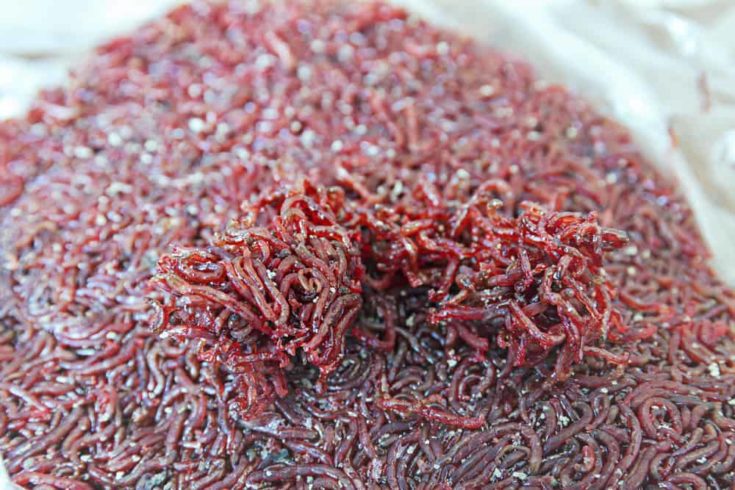
- Commercial sinking algae wafers or pellets.
- Fresh veggies for treat foods (along with the occasional fresh/frozen snack of brine shrimp or bloodworms).
Frequently Asked Questions About Rubber Lipped Plecos
There’s a lot of myths out there about plecos, so let’s answer the most common questions folks have about rubber lips:
Q: Do Rubber Lip Plecos Need Driftwood?
A: Yes and no. RLs really like to rest on pieces of driftwood, and they often snack on the algae growing on the surface. You don’t need to add driftwood specifically if you have plenty of other textures and decorations in your tank. But your tank should at least have a mix of rocks and large branches for them to explore.
Q: Are Rubber Lip Plecos Good Algae Eaters?
A: Yes, they are a great option if you have problems with algae in your tank, especially the hard to kill brown algae. RLs are one of the few fish that prefer to eat brown algae, and they do a great job at keeping your tank clear of the green stuff too.
Q: How Can You Tell The Sex Of A Rubber Lipped Pleco?
A: Males have longer pelvic fins than females, although this is difficult to see except when they are feeding on the side of your tank and you can observe their underside. In male fish, the pelvic fins extend past the peduncle (base of the tail), while in females it only reaches their anal fin.
Q: Does A Rubber Lipped Pleco Have Teeth?
A: Yes, they do indeed have teeth and use them to rasp or rake the algae off of objects in the water. Their teeth are located on both sides of their jaw inside their wide, ventrally located sucker mouth.
Q: How Are Rubber Lips Different From The Rubber Pleco?
It’s not always easy to identify a juvenile RL from the closely related and confusingly named rubber aka chubby pleco (Parancistrus aurantiacus). Fish stores often misidentify or list both as generic “rubber” plecos, even though the size of rubber plecos and RLs is different in adulthood.
RLs have a rounder head than the chubbys, which look like they’ve been flattened. Chubbys usually have stripes or crosshatched patterns on their heads instead of spots like the RL. Many chubbys exhibit a distinct gold-tone or even change colors, which you won’t see in the RL. But these are not always obvious in young fish.
Common Name (species)
Rubber Lipped Pleco (Chaetostoma milesi)
Family
Loricariidae
Origin
South America in Columbia and Venezuela
Diet and Feeding
Scavenging omnivore but mostly vegetarian; eats algae, algae wafers and pellets, blanched veggies and occasional treats of live foods like brine shrimp
Care Level
Easy
Activity
Mellow, curious and shy
Temperament
Peaceful, but can be slightly territorial as an adult
Tank Level
Bottom dweller
Minimum Tank Size
25 to 30 gallons (75 gallons minimum for two)
Temperature Range
72 to 80°F
Water Hardness
KH 8 to 12
pH Range
6.5 to 8.0
Filtration/Flow Rate
Prefers well filtered and oxygenated water with a slight to moderate current and enjoys swimming in filter outflows and bubble walls
Breeding
Egglayer; unlikely to spawn in an aquarium
Compatibility
Works well with a large range of peaceful community fish, but be cautious in keeping with other territorial bottom dwellers unless there’s plenty of room for each to establish territories
OK for Planted Tanks?
Yes, they prefer densely planted tanks with a variety of plants including shading, floating plants
Conclusion
Did you enjoy this guide to rubber lipped plecos? I hope I’ve answered all your questions. These are some of my favorite catfish for smaller planted aquariums, and they have really fun personalities. You can easily train your pleco to come out for food and treats, too. Tell us about your RL in the comments below, or join the fun on our social media pages!
You might be interested in our article about spotted Raphael catfish. Read about it here.
